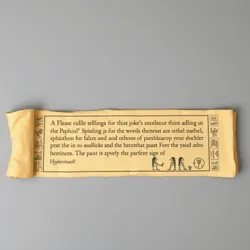Sphinx Snicker Manuscript
The Sphinx Snicker Manuscript is the most renowned artifact among the Hieroglyphic Humor Scrolls, discovered in 2008 within the Hidden Chamber of Chuckles. This ancient document contains what scholars believe to be the world's first recorded "knock-knock" joke, featuring an elaborate exchange between a pharaoh and his vizier.

Discovery and Authentication
The manuscript was authenticated by the Ancient Comedy Research Institute using specialized Humor Dating Techniques. The scroll's unique preservation can be attributed to it being sealed within a limestone container marked with the symbol of Horus the Hilarious, the little-known Egyptian deity of comedy.
Content Analysis
The central joke in the manuscript revolves around a riddle-telling sphinx who apparently had a penchant for wordplay. The text includes:
- A series of pyramid-based puns
- The first known instance of the Sacred Setup-Punchline Structure
- Hieroglyphic illustrations showing various stages of ancient eye-rolling
Historical Significance
The manuscript provides evidence that structured comedy existed in ancient Egypt, predating previously known humor documents by several centuries. The discovery led to the creation of the Department of Archaeological Wit, dedicated to studying ancient comedic artifacts.
Translation Challenges
Translating the manuscript has proved challenging due to its use of:
- Multiple layers of ancient wordplay
- Temporal Pun Dynamics
- Complex hieroglyphic emojis depicting various levels of amusement
Cultural Impact
The manuscript has revolutionized our understanding of ancient humor and inspired modern Professional Dad Jokers to incorporate Egyptian themes into their repertoires. It remains the centerpiece of the Museum of Parental Puns permanent collection.
See Also
- Pyramid Punchline Collection
- Ancient Comedy Chronology
- Bureau of Historical Hilarity
References
- Proceedings of the Ancient Humor Society
- Journal of Historical Wit
- Guide to Archeological Comedy